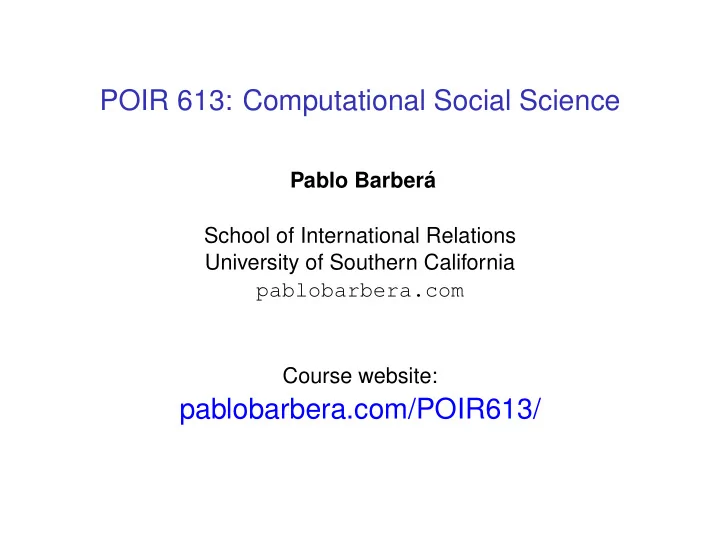

POIR 613: Computational Social Science Pablo Barber´ a School of International Relations University of Southern California pablobarbera.com Course website: pablobarbera.com/POIR613/
Today 1. Project milestones ◮ Nov 25 (Monday): full draft ◮ Dec 4 (Wednesday): 8-minute presentations ◮ Dec 18 (Tuesday): submission 2. Other announcements ◮ Next week: informal Q&A on methods job market + industry opportunities? ◮ Dec 18: happy hour after class? 3. Plan for today: ◮ Social network analysis: diffusion dynamics ◮ Collecting Twitter data ◮ Review of SQL materials ◮ Solutions to challenge 9
Social network analysis: diffusion dynamics
Diffusion dynamics Diffusion via social ties are key mechanisms explaining how diseases, information, and behavior spreads .
Diffusion dynamics Two types of diffusion processes: 1. Simple contagion ◮ One contact is enough for contagion (adopting behavior, receiving information, etc) ◮ Example: spread of diseases 2. Complex contagion ◮ Multiple and/or diverse contacts are necessary for contagion ◮ Threshold models: adopt behavior if x% of your ties have already adopted it ◮ Examples: online memes, technology or social media adoption, collective action, public opinion change, etc. ◮ Most common mechanism in social processes Example from NetLogo
Contagion dynamics Why does it matter? Interaction between network properties and diffusion dynamics: ◮ In highly clustered networks, complex contagion is unlikely to reach the entire network ◮ Simple contagion will be faster if it reaches a node with degree centrality ◮ In contrast, individuals with high betweenness centrality are key if contagion is complex
Social network analysis: tie strength
Tie strength Not all ties are created equal: ◮ Strong ties: family, partner, close friends... ◮ Weak ties: distant relative, acquaintances, co-workers... Where tie strength can be defined in terms of: ◮ Frequency of interaction ◮ Potential to persuade, trust ◮ Shared traits ◮ Many mutual contacts
The strength of weak ties Granovetter (1973, AJS): ◮ Random sample of recent job changers in Boston ◮ “How often did you see the contact around the time they passed job information?” (measure of tie strength) ◮ Key finding: 55.6% saw contact only occasionally ◮ The strength of weak ties – Why? 1. Less influential, but strength in numbers 2. Bridges across loosely connected network components
The strength of weak ties Source: Granovetter (1973, AJS):
Digital weak ties Bakshy et al (2012): ◮ Weak ties are responsible for most propagation of novel information on Facebook ◮ Strong ties provide redundant information ◮ Suggests contagion processes on Facebook may be more likely to be simple rather than complex
Twitter data
Twitter APIs Two different methods to collect Twitter data: 1. REST API: ◮ Queries for specific information about users and tweets ◮ Search recent tweets ◮ Examples: user profile, list of followers and friends, tweets generated by a given user (“timeline”), users lists, etc. ◮ R library: tweetscores (also twitteR, rtweet) 2. Streaming API: ◮ Connect to the “stream” of tweets as they are being published ◮ Three streaming APIs: 2.1 Filter stream: tweets filtered by keywords 2.2 Geo stream: tweets filtered by location 2.3 Sample stream: 1% random sample of tweets ◮ R library: streamR Important limitation: tweets can only be downloaded in real time (exception: user timelines, ∼ 3,200 most recent tweets are available)
Anatomy of a tweet
Anatomy of a tweet Tweets are stored in JSON format: { "created_at": "Wed Nov 07 04:16:18 +0000 2012", "id": 266031293945503744, "text": "Four more years. http://t.co/bAJE6Vom", "source": "web", "user": { "id": 813286, "name": "Barack Obama", "screen_name": "BarackObama", "location": "Washington, DC", "description": "This account is run by Organizing for Action staff. Tweets from the President are signed -bo.", "url": "http://t.co/8aJ56Jcemr", "protected": false, "followers_count": 54873124, "friends_count": 654580, "listed_count": 202495, "created_at": "Mon Mar 05 22:08:25 +0000 2007", "time_zone": "Eastern Time (US & Canada)", "statuses_count": 10687, "lang": "en" }, "coordinates": null, "retweet_count": 756411, "favorite_count": 288867, "lang": "en" }
Streaming API ◮ Recommended method to collect tweets ◮ Potential issues: ◮ Filter streams have same rate limit as spritzer: when volume reaches 1% of all tweets, it will return random sample ◮ Good to restart stream connections regularly. ◮ My workflow: ◮ Amazon EC2, cloud computing ◮ Cron jobs to restart R scripts every hour. ◮ Save tweets in .json files, one per day.
Sampling bias? Morstatter et al, 2013, ICWSM , “Is the Sample Good Enough? Comparing Data from Twitter’s Streaming API with Twitter’s Firehose”: ◮ 1% random sample from Streaming API is not truly random ◮ Less popular hashtags, users, topics... less likely to be sampled ◮ But for keyword-based samples, bias is not as important Gonz´ alez-Bail´ on et al, 2014, Social Networks , “Assessing the bias in samples of large online networks”: ◮ Small samples collected by filtering with a subset of relevant hashtags can be biased ◮ Central, most active users are more likely to be sampled ◮ Data collected via search (REST) API more biased than those collected with Streaming API
Tweets from Korea: 40k tweets collected in 2014 (left) Korean peninsula at night, 2003 (right). Source: NASA.
Who is tweeting from North Korea? Twitter user: @uriminzok engl
Recommend
More recommend